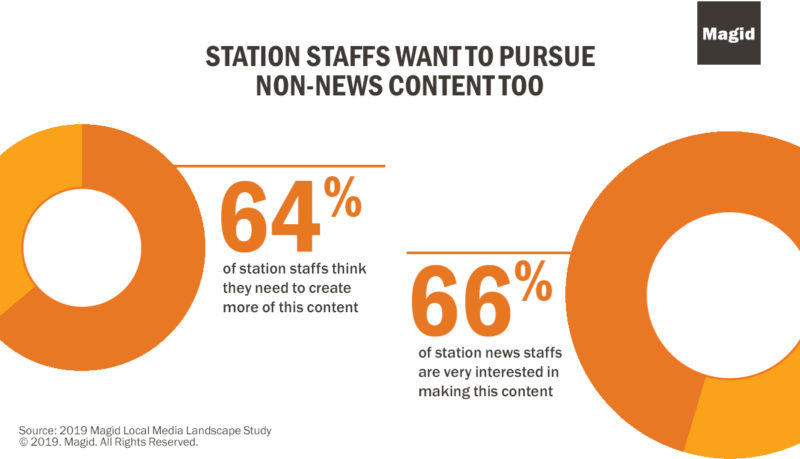How to create local content that extends beyond news – and why you should
Each year, Magid’s local media team challenges itself to define clear perspectives on the broadcast industry that will guide our thinking and approach throughout the year. Our process this year has been particularly insightful, as we have expanded our approach to look not only at the consumers our clients want to reach, but the advertisers buying their inventory, and the employees who do the work each day. This complete view of the landscape has been a powerful tool in defining the very real challenges broadcasters face in 2019, as well as the opportunities that can make for growing businesses in the future.
 We’ve been sharing highlights of our findings from this process in a series of posts that look at the path forward for your brands and content, the key to aligning station staffs, and how to create emotional connections between the consumer and your brand. This week we’re looking at content strategies to expand our focus beyond traditional local news.
We’ve been sharing highlights of our findings from this process in a series of posts that look at the path forward for your brands and content, the key to aligning station staffs, and how to create emotional connections between the consumer and your brand. This week we’re looking at content strategies to expand our focus beyond traditional local news.
Content opportunities are broader than your current focus.
Millennials now make up more than 60% of the 25-54 age demographic – and they connect with brands and content differently than previous generations. In a previous post, we looked at not just how they connect, but why: they’re seeking emotional connections to the content and brands they engage with. They’re looking for emotionally engaging brands that extend beyond functional news and deliver a broader array of content.
Magid research identified the top types of non-news information consumers are interested in, including topic areas that would particularly attract a Millennial audience: events/things to do, how to save money, food and dining, outdoor activities and things to do with kids.
Consumers want local content beyond news – and your staff agrees.
Consumers aren’t the only ones looking for content that extends beyond traditional local news. Station staffs tell us they are not only interested in making this type of content, they see it as an imperative to create it.
Advertisers want non-news content too.
Non-traditional content also delivers the opportunity to offer more advertising solutions without being held back by our news brand.
30-50% of advertisers we surveyed said they were very interested in associating with these types of non-news content – particularly interactive ads on TV, product placement, sponsoring OTT programs and ads on pause screen. This can be an opportunity to engage with advertisers in different formats.
So why haven’t we taken the opportunity to own our markets by making a stronger push in this untapped area? Now’s the time to own this type of content, particularly as we look to reach new consumers in different ways.
When consumers ask for news and information, will your brand get picked?
In addition to considering new types of content to explore to extend our reach, we also need to be aware of new channels we could be tapping into to reach new consumers and maintain current audiences. Voice technology and voice assistants, for example, present a significant opportunity for stations to increase audience and drive emotional connection.
Not only do consumers ask Alexa or Google for an update on the news and weather, they’re also using voice assistants to discover new things to do in their local community. What better source to provide this type of information than their local news station?
Recent Magid research tells us that consumers not only see many benefits of accessing branded content (in other words, branded skills) on their voice assistants – they also are more likely to have positive impressions of brands who make content available.
As more consumers adopt voice assistants into their lives, stations will need to more deeply understand rapidly evolving consumer perceptions on the role brands can and should play in this new space. Thinking beyond a functional news brand and traditional ways of reaching consumers, while embracing new technology and trends, will help open doors with advertisers, empower staff and position stations for future success.





